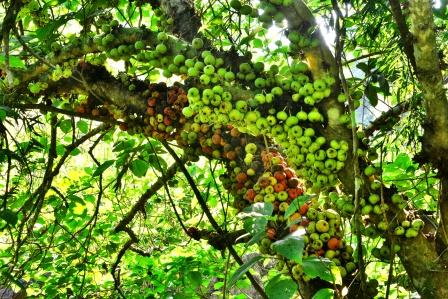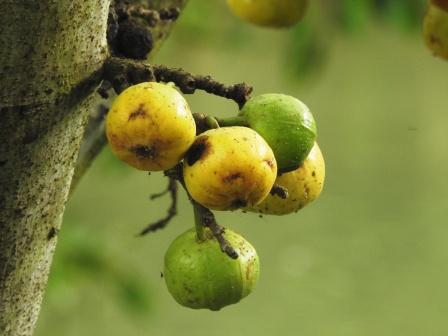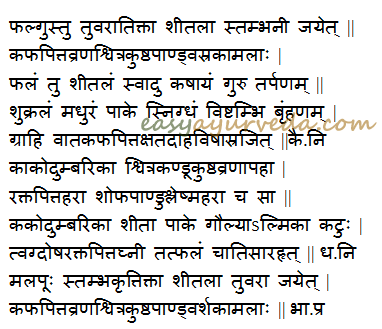Ficus hispida – Kakodumbara Uses, Research, Remedies, Side Effects
Kakodumbara- Ficus hispida is an Ayurvedic herb used for the treatment of skin diseases, wounds, fever and to increase breast milk in lactating women.
Latin name- Ficus hispida Linn.
Family- Urticaceae (Vata Kula)

Table of Contents
Vernacular names
Kakodumbar – Names in different languages:
Hindi name- Kathumar, Kathgular
English name- Hairy Fig, devil fig, opposite leaved fig,
Arabic name- Tin basin
Assamese name- Khoskadumar
Bengali name- Kakadumbar
Gujarathi name- Devadavari
Kannada name- Kaadu atti mara
Marathi name- Bhuidambar, Bokhada
Malayalam name- Katiatti, Erum anakku, Parakam
Nepalese name- Koksa, Kharwa
Punjabi name- Daduri, Degar, Rumbal
Tamil name- kattu athith, Peyatti, Conatti
Telugu name- Adavi alhith
Uttar Pradesh Hills – Gobla Kaksha, Ghegsha, Gebha
Persian – Ajirdasti
Burmese name – Kaaung, Kadot Kadut
DehraDun – Ghogsha
Nepal – Kharwa, Koksa
Bombay – Dhedu, Dumbar, Kurout
Sanskrit Synonyms
Kakodumbari:- This fruit is more eaten by the crows/ build nest in this tree.
Jaghanephala:- Fruits are attached to main stem.
Kashtodumbara- The fruits are hard like wood
Phalgu Shivatika, Phalgu: It yields more fruits.
Malapu:- It cures diseases like vitiligo etc.
Malayu:- Useful in leucoderma
Rajaphalgu:- It will possess bigger fruits compared to thse of udumbara.
Shwitrabhesaja:- Its bark is considered as the drug of choice in leucoderma .
Sthanya pradayini- Increase breast milk in lactating women
Phalasambhari, Jaghane phala, Phalabharika – figs – fruits are heavy, abundant
Bhadra – auspicious
Udumbari – resembles Udumbar – Ficus racemosa in qualities
Kaksha, Phanika, Araji, Manjari, Masura, Phalguvati, Moolakarkati

Morphology
Kakodumbara is a small tree found all over the temperate climate of India. Small hair-like structures are found covering the branches. The tree is not strong and often hollow between the branches and main stem. The leaves are oval to renal shaped, 4-6 inch long, and have hair-like structure in the lower surface. The fruits are round, covered with hair like structure, found growing directly on the main stem. Fruits become yellow when ripe. Flowers are seen after the rainy season and the fruits are seen in the month of January to March.
Properties, part used, dosage
Properties:
Rasa (Taste) Tikta (Bitter), Kashaya (Astringent)
Guna (Qualities) – Laghu (Light for digestion), Ruksha (Dry in nature)
Vipaka – Katu (Undergoes Pungent taste after digestion)
Veerya (Potency) – Sheeta (Cold)
Karma (Actions) – Pitta shamaka (reduces vitiated pitta dosha)
Part used- Root bark, Fruit latex
Dosage-
Bark powder- 1 to 3 g
Decoction- 50-100 ml
Chemical composition
Chemical composition of Ficus hispida:
The fruit and the bark of the plant contain beta- sitosterol, beta- amyrin, n- triacontanyl acetate, gluacol acetate, hispidin, bergapten and psoralen. Bark also contains tannin, glucoside, wax & saponin Leaves contain oleanolic acid and phenanthroindolizidine alkaloids. Root contains leucocyanin.
Uses
Medicinal uses of Ficus hispida:
- The fruit and bark of the tree is used for inducing purgation and emesis to remove excess pitta dosha from the body.
- Decoction from the bark of Kakodumbara is given in a dose of 40-50 ml to treat fever.
- The ripened fruit of Kakodumbara provides strength and nourishment to the body.
- The powder of the root bark of Ficus hispida is applied over the area affected with eczema
- The latex obtained from the fruit is applied directly over the fresh wound for quick healing and over the area having ringworm for treatment.
- Decoction prepared from the fruit or bark of the Ficus hispida is given in a dose of 50 ml to treat jaundice, piles and distention of abdomen.
- The fruit juice of ripened Ficus hispida along with honey acts as anti- hemorrhagic.
- Consuming the ripened fruit is a good source for increasing the breast milk in lactating women.
- Root powder in a dose of 3-5 gm is given with buttermilk to increase the appetite and improve digestion.
- In case of vitiligo, latex of unripe fruit of Ficus hispida is given with jiggery to induce purgation as part of treatment.
- To treat diarrhea, decoction of bark of Ficus hispida along with tender leaf of mango is prepared and given in a dose of 40-50 ml.
- In cases of excessive bleeding during menstruating, the fruit of Kakodumbara along with honey is given to provide strength to the body and control bleeding.
- In case of dog bite, intake of Kakodumbara root mixed with Dhattura seeds (Nux vomica) along with rice water destroys
- To treat diabetic ulcers, the latex of unripe fruit of Kakodumbara is applied over the ulcers.
- To treat cervical spondylitis, latex of the fruit is mixed with Hingu (Asafoetida) and the root of Kapikachu (Mucuna prurita) powder is used as nasal snuff.
Sanskrit verse

Traditional uses, Indications
Traditional uses of Kakodumbar:
Sheetala – coolant
Stambhani – stops, checks flow, fluids.
Indications:
Vrana – Ulcers, wounds
Shvitra – leucoderma, vitiligo
Kushta – skin diseases
Pandu – anemia
Asra – blood disorders such as abscess, skin disorders, bleeding disorders such as menorrhagia, nasal bleeding etc.
Kamala – Jaundice, Liver diseases
Fruits are –
Sheetala – coolant
Swadu – sweet taste
Kashaya – astringent
Guru – heavy to digest
Tarpana – rich in nutrition
Shukrala – improves sperm and semen quantity and quality
Madhura Vipaka (taste conversion after digestion) – sweet
Snigdha – unctuous, oily
Vishtambhi – causes constipation.
Brimhana – causes weight gain
Grahi – absorbent, useful in diarrhea, IBS
Indicated in –
Kshata – injury, bleeding
Daha – burning sensation, as in gastritis, neuropathy, burning sensation in eyes etc
Visha – Toxic conditions, poisoning
Asra – blood disorders such as abscess, skin disorders, bleeding disorders such as menorrhagia, nasal bleeding etc.
1) In Shwitra (vitiligo), the best purgative is juice of Kakodumbara mixed with jaggery – (Ch Ch 7/159)
2) In Yoniroga – gynecological disorders with heavy bleeding, white discharge etc – the latex of kakodumbara is given 6 times bhavana with tila and from these tila and udumbara swarasa, the taila is prepared. By dharana of this taila, the yoni becomes drudha (firm) and swaccha (cleansed). (Ch Chi 30/75)
3) In Pittatisara, the kwatha prepared from leaves of mango plant & kakodumbara is given internally.( Ch Su 27/100)
4) In Raktapitta, the swarasa taken from kakodumbara phala , given internally ( Su Ut 45/23)
5) In Trishna – dry mouth, the kwatha prepared from this is given internally ( Su Ut 48/22)
6) In Raktapradara, one should take the juice of kakodumbara fruits mixed with honey in order to alleviate pradara while keeping on the diet of cereals with milk and sugar.(Bhavaprakasha)
7)In Vatavikara, the latex of kakodumara mixed with hingu, nasya given from this cures the disease named avabahuka (Bhangasena)
8) In Alarkavisha (rabies),intake of kakodumbara root mixed with Datura seeds along with rice water destroys rabies( Bhangasena).
9) In Raktapitta, Swarasa of Kakodumbara along with honey given internally( Chakradatta)
10) Prameha pitakas ,lepa done by the latex of Kakodumbara (Shodala nighantu)
11) In cough and asthma, the tender leaves of kakodumbara are pounded and cooked with cow milk which is thereafter added with a bit of pipalli. By taking this milk in the morning, one is freed from all types of cough and asthma.
12) In intrinsic haemorrhage, the root of kakodumbara is pounded with rice water and ingested with the same. It checks hemorrhage from the mouth.
13) In Avabahuka, the latex of kakodumbara, mixed with hingu and root of kapikachu taken as snuff, removes the pain of avabahuka.
14) In Upakusha, it should be perforated and discharged with the leaves of kakodumbara..
15) Fruit juice mixed with honey is anti-hemorrhagic.
16) Bark when taken in a small dose of 1.2 to 1.8g. acts as a good tonic and also shows prophylactic activity.17) The drug is anabolic, antihistaminic, antiseptic, aphrodisiac and astringent. It is used in anemia, diarrhea, dysentery, emaciation, jaundice, skin disease, vitiligo and wounds.
Adverse effect
Mild purgation is seen after the intake of fruit latex.
Fruits can cause constipation.
Interaction with medicines, supplements
Can this be used while taking Homeopathic medicine?
Yes. This product does not react with homeopathic medicine.
Can this medicine be continued while taking supplements like multivitamin tablets, Omega 3 fatty acids etc?
Yes. Generally, this product goes well with most dietary supplements. However, if you are taking more than one product per day, please consult your doctor for an opinion.
With western
medicines
Seek your
doctor’s advice if you are taking this product along with other western
(allopathic / modern) medicines. Some Ayurvedic herbs can interact with modern
medicine.
If both Ayurvedic and allopathic medicines are advised together, then it is
best to take Allopathic medicine first, wait for 30 minutes and then take the
Ayurvedic medicine.
Ayurvedic medicines
Ayurvedic medicines containing Kakodumbara:
Gojihwadi kashaya: It is an Ayurvedic medicine in water decoction form. It is used in the treatment of fever, cough, bronchitis, asthma etc.
Research
Research articles related to Ficus hispida:
Anti- nociceptive action: The present study set out to evaluate the in vivo antinociceptive, anti-inflammatory, and sedative activity of the ethanol extract of Ficus hispida bark (EFHB). The anti-nociceptive activity of EFHB was evaluated by using acetic acid induced writhing, formalin, hot plate, and tail immersion methods in Swiss albino mice. EFHB demonstrated anti-nociceptive activity both centrally and peripherally. It showed 62.24% of writhing inhibition. It significantly inhibited licking responses in early (59.29%) and late phase (71.61%). It increased the reaction time to the thermal stimulus in both hot plate and tail immersion. It inhibited the inflammation to the extent of 59.49%. A substantial increase in duration of sleep up to 60.80 min and decrease of locomotion up to 21.70 at 400 mg/kg were also observed.
Anti- diarrheal study: Methanol extract of Ficus hispida L. showed significant inhibitory activity against castor oil-induced diarrhea and PGE(2)-induced enteropooling in rats. It also showed a significant reduction in gastro-intestinal motility on charcoal meal tests in rats. The results obtained establish the F. hispida leaf extract as an antidiarrheal agent.
Classical categorization
Charaka Samhita – Tikta Skandha – bitter tasting group of herbs
Dhanwanthari Nighantu – Amradi Varga
Kaiyyadeva Nighantu – Oshadhi Varga
Priya Nighantu – Haritakyadi Varga
Bhavaprakasha – Vatadi Varga
Raj Nighantu – Amradi Phala Varga
Bhavaprakasha, Nighantu Adarsha – Vatadi Varga
Raja Nighantu – Amradi Phala Varga
Scientific classification
Kingdom: Plantae
Order: Rosales
Family: Moraceae
Genus: Ficus
Species: F. hispida
Traditional reference
In Chikitsa sthana of Charaka samhitha Kakodumbara is used in the treatment of leucoderma (7/159), genital disorders (30/75), in increased digestive fire (15/227) & in blood disorders (28/100).
Sushruta Samhita – Kakodumbara with other drugs paste is applied on patches of leprosy (9/10 Kusthadhyaya)
Avalgujadi lepa which in prepared from kakodumbra and other drugs, cures leucoderma (Kusthtadhyaya)
In Vridhi, upadamsha and shleepada chikitsa, Sushrutha mentioned that, the alkali prepared from kakadani, kakajangha etc drugs when consumed cures slipada, goiter,cervical lymphadenitis, diseases of the duodenum, inability to eat food & all kinds of poisons.
Kakodumbara has also been mentioned as a drug by Acharya Sushrutha, in the treatment of mukharoga (22/19).
In Sushrutha Samhitha, Uttaratantra, Acharya Sushrutha mentioned the use of kakodumbara in the treatment of panajurna.(36)
In Ashtanga Hridaya
In chikitsa sthana, Acharya Vagbhata has mentioned that the decoction of verksaka added with paste of kakodumbarika, vella, nimba, abola and vyosa, when consumed cures all diseases of skin (chi – 19)
Author: Dr.B.K.Prashanth M.D (Ayu), Ph.D
E mail: [email protected]
Click to consult Dr Prashanth BK
Sthanika Karma (Systemic Action)
External Application – External application of its root bark paste and latex Indicated in skin lesions, leukoderma, dadru kushta etc. Its latex causes blistering and has scraping action. Promote wound healing. Its decoction and powder can be applied on wounds. fruit is indicated in Cervical lymph node enlargement.
Internal administration-
Digestive System – Fruit and bark has purgative, and emetic action. Helps to eliminate excess pitta dosha from the body. Indicated in abdominal distension, hemorrhoids, and jaundice.
Circulatory system – reduce edema, blood purifier, Mature fruit juice is indicated in bleeding disorders.
Reproductive system – Stimulate breast milk production. Fruit can be given to breastfeeding mothers.
Satmikarana – Fruit is sweet in taste, promotes body strength, Aphrodisiac, and enhances body bulk. Its fruit is indicated in general debility. Root bark powder in lower doses can be administered in low digestive fire after fever.
Tvak (Skin) – root and fruit are indicated in all types of skin diseases including Leukoderma.
Tapakrama – Indicated in fever










